| Listing 1 - 7 of 7 |
Sort by
|
Book
Year: 2011 Publisher: Bruxelles: UCL,
Abstract | Keywords | Export | Availability | Bookmark
 Loading...
Loading...Choose an application
- Reference Manager
- EndNote
- RefWorks (Direct export to RefWorks)
Acute kidney injury (AKI) is a frequent and serious complication for hospitalized patients. In spite of considerable improvement in treatments, the morbidity and mortality associated with acute kidney injury remains relatively high. The major reason being that, at the moment, we don’t know of any sensitive and specific markers of the renal function which would allow for an early diagnosis of acute kidney injury. At present, traditional biomarkers of the renal function (creatinine and urea) do not detect kidney injury early enough. In renal transplantation, the identification of adequate biomarkers of the renal function are indispensable to evaluate the quality of the transplant before the transplantation but also to minimize the risk of acute rejection and acute tubular necrosis during the post-operative period. Neutrophil Gelatinase-Associated Lipocalin (NGAL) is an early biomarkers of acute kidney injury. This marker of tubular necrosis has been measured in the urine and in the blood of 54 patients before and at different time after a renal transplantation. Other biomarkers of the renal function (Cystatine C and β2-Microglobuline) have also been tested. The aim of the study is on the one hand to test the various biomarkers of “donor” patients according to their category (living or cadaveric donors’kidneys) and on the other hand to study these biomarkers for the “recipient” patients according to the events that occurred during the post-operative period. The preliminary results show that 13 patients developed an acute tubular necrosis (ATN) within the first 24 hours post-operation. The statistical tests show that the rates of urinary and blood NGAL were significantly higher for the patient’s who developed an ATN compared with those who didn’t. Furthermore, this difference between both groups is observed within 6 hours after the transplantation. L’atteinte rénale aiguë est une complication fréquente et sérieuse chez les patients hospitalisés. Malgré une amélioration considérable en matière de traitements, la morbidité et la mortalité associées à une atteinte rénale restent relativement élevées. La raison majeure vient du fait qu’on ne dispose pas, à l’heure actuelle, de marqueurs sensibles et spécifiques de la fonction rénale qui permettraient un diagnostic précoce de l’atteinte rénale aiguë. Actuellement les marqueurs principaux de la fonction rénale sont la créatinine et l’urée. Malheureusement ceux-ci ne détectent que tardivement des lésions rénales aiguës. Dans le domaine de la transplantation rénale, l’identification de biomarqueurs adéquats de la fonction rénale est devenue indispensable afin d’évaluer la qualité du greffon avant la transplantation mais également afin de minimiser le risque de rejet et de nécrose tubulaire aigu pendant la période postopératoire. La Neutrophil Gelatinase-Associated Lipocalin (NGAL) est un marqueur précoce d’atteinte rénale aiguè. Ce marqueur de nécrose tubulaire a été dosé dans l’urine et dans le sang de 54 patients avant et à différents temps après une transplantation rénale. D’autres marqueurs alternatifs de la fonction rénale ont également été testés comme la cystatine C et la f32 Microglobuline. L’objectif de l’étude est d’une part de tester les différents biomarqueurs chez les patients «donneurs» en fonction de leur catégorie (donneurs vivants ou donneurs cadavériques) et d’autre part d’étudier ces biomarqueurs chez les patients «receveurs» en fonction des événements survenus durant la période postopératoire. Les résultats préliminaires montrent que 13 patients ont développé une nécrose tubulaire aigu (ATN) endéans les 24H postopératoires. Les tests statistiques ont démontré que les taux de NGAL urinaire et sanguin étaient significativement plus élevés chez les patients ayant développé une ATN comparés aux patients qui n’ont pas fait d’ATN. De plus, cette différence entre les deux groupes s’observe endéans les 6H post-transplantation
Acute Kidney Injury --- Kidney Tubular Necrosis, Acute --- Biological Markers

ISBN: 0080426964 9780080426969 9780080540757 0080540759 1281028649 9781281028648 9786611028640 6611028641 Year: 1999 Publisher: Amsterdam ; New York : Elsevier,
Abstract | Keywords | Export | Availability | Bookmark
 Loading...
Loading...Choose an application
- Reference Manager
- EndNote
- RefWorks (Direct export to RefWorks)
Carbon Nanotubes (CNT) is the material lying between fullerenes and graphite as a new member of carbon allotropes. The study of CNT has gradually become more and more independent from that of fullerenes. As a novel carbon material, CNTs will be far more useful and important than fullerenes from a practical point of view, in that they will be directly related to an ample field of nanotechnology. This book presents a timely, second-generation monograph covering as far as practical, application of CNT as the newest science of these materials. Most updated summaries for preparation, purific
Electronics and optics of solids --- Carbon --- Nanostructured materials --- Tubes --- Tubes. --- Carbon. --- Nanostructured materials. --- Nanomaterials --- Nanometer materials --- Nanophase materials --- Nanostructure controlled materials --- Nanostructure materials --- Ultra-fine microstructure materials --- Microstructure --- Nanotechnology --- Group 14 elements --- Light elements --- Tubing --- Tubular goods --- Shells (Engineering)
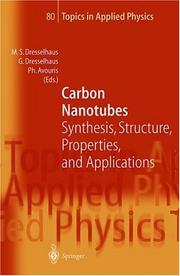
ISBN: 3540410864 354039947X 9783540410867 Year: 2001 Volume: v. 80 Publisher: Berlin: Springer,
Abstract | Keywords | Export | Availability | Bookmark
 Loading...
Loading...Choose an application
- Reference Manager
- EndNote
- RefWorks (Direct export to RefWorks)
This book gives a comprehensive review of the present status of research in this fast moving field by researchers actively contributing to the advances. After a short introduction and a brief review of the relation between carbon nanotubes, graphite and other forms of carbon, the synthesis techniques and growth mechanisms for carbon nanotubes are described. This is followed by reviews on nanotube electronic structure, electrical, optical, and mechanical properties, nanotube imaging and spectroscopy, and nanotube applications.
Carbon. --- Nanostructured materials. --- Tubes. --- Carbone --- Nanomatériaux --- Tubes --- Carbon --- Nanostructured materials --- Tubing --- Tubular goods --- Shells (Engineering) --- Nanomaterials --- Nanometer materials --- Nanophase materials --- Nanostructure controlled materials --- Nanostructure materials --- Ultra-fine microstructure materials --- Microstructure --- Nanotechnology --- Group 14 elements --- Light elements --- Nanotechnology. --- Surfaces (Physics). --- Characterization and Evaluation of Materials. --- Physics --- Surface chemistry --- Surfaces (Technology) --- Molecular technology --- Nanoscale technology --- High technology --- Materials science. --- Material science --- Physical sciences
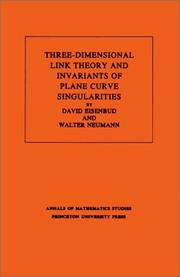
ISBN: 0691083819 0691083800 1400881927 9780691083810 9780691083803 Year: 1985 Volume: 110 Publisher: Princeton (N.J.): Princeton university press,
Abstract | Keywords | Export | Availability | Bookmark
 Loading...
Loading...Choose an application
- Reference Manager
- EndNote
- RefWorks (Direct export to RefWorks)
This book gives a new foundation for the theory of links in 3-space modeled on the modern developmentby Jaco, Shalen, Johannson, Thurston et al. of the theory of 3-manifolds. The basic construction is a method of obtaining any link by "splicing" links of the simplest kinds, namely those whose exteriors are Seifert fibered or hyperbolic. This approach to link theory is particularly attractive since most invariants of links are additive under splicing.Specially distinguished from this viewpoint is the class of links, none of whose splice components is hyperbolic. It includes all links constructed by cabling and connected sums, in particular all links of singularities of complex plane curves. One of the main contributions of this monograph is the calculation of invariants of these classes of links, such as the Alexander polynomials, monodromy, and Seifert forms.
Algebraic geometry --- Differential geometry. Global analysis --- Link theory. --- Curves, Plane. --- SINGULARITIES (Mathematics) --- Curves, Plane --- Invariants --- Link theory --- Singularities (Mathematics) --- Geometry, Algebraic --- Low-dimensional topology --- Piecewise linear topology --- Higher plane curves --- Plane curves --- Invariants. --- 3-sphere. --- Alexander Grothendieck. --- Alexander polynomial. --- Algebraic curve. --- Algebraic equation. --- Algebraic geometry. --- Algebraic surface. --- Algorithm. --- Ambient space. --- Analytic function. --- Approximation. --- Big O notation. --- Call graph. --- Cartesian coordinate system. --- Characteristic polynomial. --- Closed-form expression. --- Cohomology. --- Computation. --- Conjecture. --- Connected sum. --- Contradiction. --- Coprime integers. --- Corollary. --- Curve. --- Cyclic group. --- Determinant. --- Diagram (category theory). --- Diffeomorphism. --- Dimension. --- Disjoint union. --- Eigenvalues and eigenvectors. --- Equation. --- Equivalence class. --- Euler number. --- Existential quantification. --- Exterior (topology). --- Fiber bundle. --- Fibration. --- Foliation. --- Fundamental group. --- Geometry. --- Graph (discrete mathematics). --- Ground field. --- Homeomorphism. --- Homology sphere. --- Identity matrix. --- Integer matrix. --- Intersection form (4-manifold). --- Isolated point. --- Isolated singularity. --- Jordan normal form. --- Knot theory. --- Mathematical induction. --- Monodromy matrix. --- Monodromy. --- N-sphere. --- Natural transformation. --- Newton polygon. --- Newton's method. --- Normal (geometry). --- Notation. --- Pairwise. --- Parametrization. --- Plane curve. --- Polynomial. --- Power series. --- Projective plane. --- Puiseux series. --- Quantity. --- Rational function. --- Resolution of singularities. --- Riemann sphere. --- Riemann surface. --- Root of unity. --- Scientific notation. --- Seifert surface. --- Set (mathematics). --- Sign (mathematics). --- Solid torus. --- Special case. --- Stereographic projection. --- Submanifold. --- Summation. --- Theorem. --- Three-dimensional space (mathematics). --- Topology. --- Torus knot. --- Torus. --- Tubular neighborhood. --- Unit circle. --- Unit vector. --- Unknot. --- Variable (mathematics).
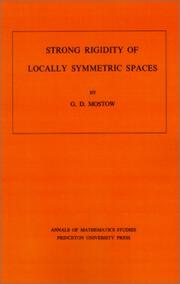
ISBN: 0691081360 1400881838 9780691081366 Year: 1973 Volume: 78 Publisher: Princeton (N.J.): Princeton university press,
Abstract | Keywords | Export | Availability | Bookmark
 Loading...
Loading...Choose an application
- Reference Manager
- EndNote
- RefWorks (Direct export to RefWorks)
Locally symmetric spaces are generalizations of spaces of constant curvature. In this book the author presents the proof of a remarkable phenomenon, which he calls "strong rigidity": this is a stronger form of the deformation rigidity that has been investigated by Selberg, Calabi-Vesentini, Weil, Borel, and Raghunathan.The proof combines the theory of semi-simple Lie groups, discrete subgroups, the geometry of E. Cartan's symmetric Riemannian spaces, elements of ergodic theory, and the fundamental theorem of projective geometry as applied to Tit's geometries. In his proof the author introduces two new notions having independent interest: one is "pseudo-isometries"; the other is a notion of a quasi-conformal mapping over the division algebra K (K equals real, complex, quaternion, or Cayley numbers). The author attempts to make the account accessible to readers with diverse backgrounds, and the book contains capsule descriptions of the various theories that enter the proof.
Differential geometry. Global analysis --- Riemannian manifolds --- Symmetric spaces --- Rigidity (Geometry) --- 512 --- Lie groups --- Geometric rigidity --- Rigidity theorem --- Discrete geometry --- Spaces, Symmetric --- Geometry, Differential --- Manifolds, Riemannian --- Riemannian space --- Space, Riemannian --- Manifolds (Mathematics) --- Groups, Lie --- Lie algebras --- Topological groups --- Algebra --- Lie groups. --- Riemannian manifolds. --- Symmetric spaces. --- Rigidity (Geometry). --- 512 Algebra --- Addition. --- Adjoint representation. --- Affine space. --- Approximation. --- Automorphism. --- Axiom. --- Big O notation. --- Boundary value problem. --- Cohomology. --- Compact Riemann surface. --- Compact space. --- Conjecture. --- Constant curvature. --- Corollary. --- Counterexample. --- Covering group. --- Covering space. --- Curvature. --- Diameter. --- Diffeomorphism. --- Differentiable function. --- Dimension. --- Direct product. --- Division algebra. --- Ergodicity. --- Erlangen program. --- Existence theorem. --- Exponential function. --- Finitely generated group. --- Fundamental domain. --- Fundamental group. --- Geometry. --- Half-space (geometry). --- Hausdorff distance. --- Hermitian matrix. --- Homeomorphism. --- Homomorphism. --- Hyperplane. --- Identity matrix. --- Inner automorphism. --- Isometry group. --- Jordan algebra. --- Matrix multiplication. --- Metric space. --- Morphism. --- Möbius transformation. --- Normal subgroup. --- Normalizing constant. --- Partially ordered set. --- Permutation. --- Projective space. --- Riemann surface. --- Riemannian geometry. --- Sectional curvature. --- Self-adjoint. --- Set function. --- Smoothness. --- Stereographic projection. --- Subgroup. --- Subset. --- Summation. --- Symmetric space. --- Tangent space. --- Tangent vector. --- Theorem. --- Topology. --- Tubular neighborhood. --- Two-dimensional space. --- Unit sphere. --- Vector group. --- Weyl group. --- Riemann, Variétés de --- Lie, Groupes de --- Geometrie differentielle globale --- Varietes riemanniennes
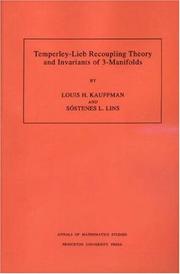
ISBN: 0691036411 0691036403 1400882532 9780691036403 9780691036410 Year: 1994 Volume: 134 Publisher: Princeton (N.J.): Princeton university press,
Abstract | Keywords | Export | Availability | Bookmark
 Loading...
Loading...Choose an application
- Reference Manager
- EndNote
- RefWorks (Direct export to RefWorks)
This book offers a self-contained account of the 3-manifold invariants arising from the original Jones polynomial. These are the Witten-Reshetikhin-Turaev and the Turaev-Viro invariants. Starting from the Kauffman bracket model for the Jones polynomial and the diagrammatic Temperley-Lieb algebra, higher-order polynomial invariants of links are constructed and combined to form the 3-manifold invariants. The methods in this book are based on a recoupling theory for the Temperley-Lieb algebra. This recoupling theory is a q-deformation of the SU(2) spin networks of Roger Penrose. The recoupling theory is developed in a purely combinatorial and elementary manner. Calculations are based on a reformulation of the Kirillov-Reshetikhin shadow world, leading to expressions for all the invariants in terms of state summations on 2-cell complexes. Extensive tables of the invariants are included. Manifolds in these tables are recognized by surgery presentations and by means of 3-gems (graph encoded 3-manifolds) in an approach pioneered by Sostenes Lins. The appendices include information about gems, examples of distinct manifolds with the same invariants, and applications to the Turaev-Viro invariant and to the Crane-Yetter invariant of 4-manifolds.
Drie-menigvuldigheden (Topologie) --- Knopentheorie --- Knot theory --- Noeuds [Theorie des ] --- Three-manifolds (Topology) --- Trois-variétés (Topologie) --- Knot theory. --- Algebraic topology --- Invariants --- Mathematics --- Invariants (Mathematics) --- Invariants. --- 3-manifolds (Topology) --- Manifolds, Three dimensional (Topology) --- Three-dimensional manifolds (Topology) --- Low-dimensional topology --- Topological manifolds --- Knots (Topology) --- 3-manifold. --- Addition. --- Algorithm. --- Ambient isotopy. --- Axiom. --- Backslash. --- Barycentric subdivision. --- Bijection. --- Bipartite graph. --- Borromean rings. --- Boundary parallel. --- Bracket polynomial. --- Calculation. --- Canonical form. --- Cartesian product. --- Cobordism. --- Coefficient. --- Combination. --- Commutator. --- Complex conjugate. --- Computation. --- Connected component (graph theory). --- Connected sum. --- Cubic graph. --- Diagram (category theory). --- Dimension. --- Disjoint sets. --- Disjoint union. --- Elaboration. --- Embedding. --- Equation. --- Equivalence class. --- Explicit formula. --- Explicit formulae (L-function). --- Factorial. --- Fundamental group. --- Graph (discrete mathematics). --- Graph embedding. --- Handlebody. --- Homeomorphism. --- Homology (mathematics). --- Identity element. --- Intersection form (4-manifold). --- Inverse function. --- Jones polynomial. --- Kirby calculus. --- Line segment. --- Linear independence. --- Matching (graph theory). --- Mathematical physics. --- Mathematical proof. --- Mathematics. --- Maxima and minima. --- Monograph. --- Natural number. --- Network theory. --- Notation. --- Numerical analysis. --- Orientability. --- Orthogonality. --- Pairing. --- Pairwise. --- Parametrization. --- Parity (mathematics). --- Partition function (mathematics). --- Permutation. --- Poincaré conjecture. --- Polyhedron. --- Quantum group. --- Quantum invariant. --- Recoupling. --- Recursion. --- Reidemeister move. --- Result. --- Roger Penrose. --- Root of unity. --- Scientific notation. --- Sequence. --- Significant figures. --- Simultaneous equations. --- Smoothing. --- Special case. --- Sphere. --- Spin network. --- Summation. --- Symmetric group. --- Tetrahedron. --- The Geometry Center. --- Theorem. --- Theory. --- Three-dimensional space (mathematics). --- Time complexity. --- Tubular neighborhood. --- Two-dimensional space. --- Vector field. --- Vector space. --- Vertex (graph theory). --- Winding number. --- Writhe.
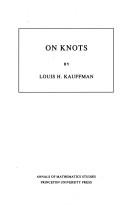
ISBN: 0691084343 0691084351 1400882133 9780691084343 Year: 1987 Volume: 115 Publisher: Princeton (N.J.): Princeton university press,
Abstract | Keywords | Export | Availability | Bookmark
 Loading...
Loading...Choose an application
- Reference Manager
- EndNote
- RefWorks (Direct export to RefWorks)
On Knots is a journey through the theory of knots, starting from the simplest combinatorial ideas--ideas arising from the representation of weaving patterns. From this beginning, topological invariants are constructed directly: first linking numbers, then the Conway polynomial and skein theory. This paves the way for later discussion of the recently discovered Jones and generalized polynomials. The central chapter, Chapter Six, is a miscellany of topics and recreations. Here the reader will find the quaternions and the belt trick, a devilish rope trick, Alhambra mosaics, Fibonacci trees, the topology of DNA, and the author's geometric interpretation of the generalized Jones Polynomial.Then come branched covering spaces, the Alexander polynomial, signature theorems, the work of Casson and Gordon on slice knots, and a chapter on knots and algebraic singularities.The book concludes with an appendix about generalized polynomials.
Knot theory --- Knots (Topology) --- Low-dimensional topology --- Knot theory. --- Algebraic topology --- 3-sphere. --- Addition theorem. --- Addition. --- Alexander polynomial. --- Algebraic variety. --- Algorithm. --- Ambient isotopy. --- Arf invariant. --- Basepoint. --- Bijection. --- Bilinear form. --- Borromean rings. --- Bracket polynomial. --- Braid group. --- Branched covering. --- Chiral knot. --- Chromatic polynomial. --- Cobordism. --- Codimension. --- Combination. --- Combinatorics. --- Complex analysis. --- Concentric. --- Conjecture. --- Connected sum. --- Conway polynomial (finite fields). --- Counting. --- Covering space. --- Cyclic group. --- Dense set. --- Determinant. --- Diagram (category theory). --- Diffeomorphism. --- Dimension. --- Disjoint union. --- Disk (mathematics). --- Dual graph. --- Elementary algebra. --- Embedding. --- Enumeration. --- Existential quantification. --- Exotic sphere. --- Fibration. --- Formal power series. --- Fundamental group. --- Geometric topology. --- Geometry and topology. --- Geometry. --- Group action. --- Homotopy. --- Integer. --- Intersection form (4-manifold). --- Isolated singularity. --- Jones polynomial. --- Knot complement. --- Knot group. --- Laws of Form. --- Lens space. --- Linking number. --- Manifold. --- Module (mathematics). --- Morwen Thistlethwaite. --- Normal bundle. --- Notation. --- Obstruction theory. --- Operator algebra. --- Pairing. --- Parity (mathematics). --- Partition function (mathematics). --- Planar graph. --- Point at infinity. --- Polynomial ring. --- Polynomial. --- Quantity. --- Rectangle. --- Reidemeister move. --- Remainder. --- Root of unity. --- Saddle point. --- Seifert surface. --- Singularity theory. --- Slice knot. --- Special case. --- Statistical mechanics. --- Substructure. --- Summation. --- Symmetry. --- Theorem. --- Three-dimensional space (mathematics). --- Topological space. --- Torus knot. --- Trefoil knot. --- Tubular neighborhood. --- Underpinning. --- Unknot. --- Variable (mathematics). --- Whitehead link. --- Wild knot. --- Writhe. --- Variétés topologiques --- Topologie combinatoire --- Theorie des noeuds
| Listing 1 - 7 of 7 |
Sort by
|

 Search
Search Feedback
Feedback About UniCat
About UniCat  Help
Help News
News